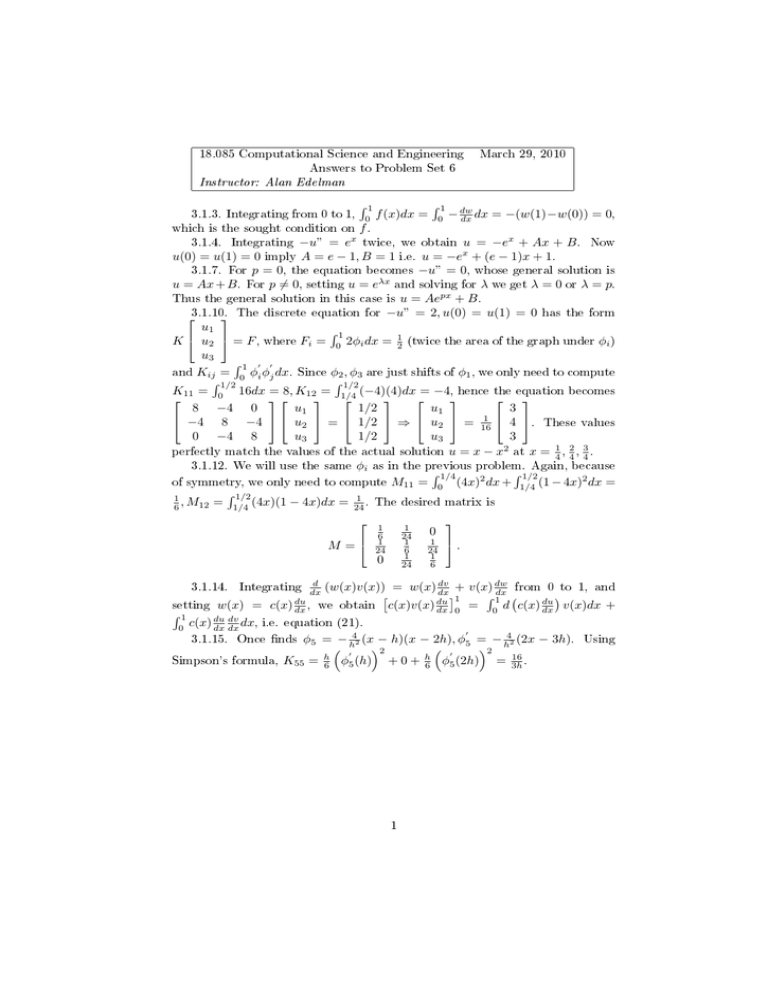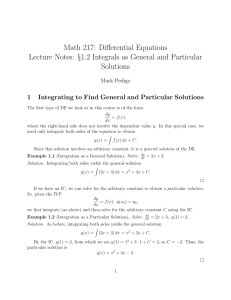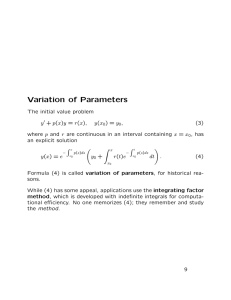18.085 Computational Science and Engineering March 29, 2010 Instructor: Alan Edelman
advertisement

18.085 Computational Science and Engineering Answers to Problem Set 6 March 29, 2010 Instructor: Alan Edelman ´1 ´1 3.1.3. Integrating from 0 to 1, 0 f (x)dx = 0 − dw dx dx = −(w(1)−w(0)) = 0, which is the sought condition on f . 3.1.4. Integrating −u” = ex twice, we obtain u = −ex + Ax + B . Now u(0) = u(1) = 0 imply A = e − 1, B = 1 i.e. u = −ex + (e − 1)x + 1. 3.1.7. For p = 0, the equation becomes −u” = 0, whose general solution is u = Ax + B . For p 6= 0, setting u = eλx and solving for λ we get λ = 0 or λ = p. Thus the general solution in this case is u = Aepx + B . 3.1.10. The discrete equation for −u” = 2, u(0) = u(1) = 0 has the form u1 ´1 K u2 = F , where Fi = 0 2φi dx = 21 (twice the area of the graph under φi ) u3 ´1 0 0 and Kij = 0 φi φj dx. Since φ2 , φ3 are just shifts of φ1 , we only need to compute ´ 1/2 ´ 1/2 K11 = 0 16dx = 8, K12 = 1/4 (−4)(4)dx = −4, hence the equation becomes 3 u1 1/2 u1 8 −4 0 −4 8 −4 u2 = 1/2 ⇒ u2 = 1 4 . These values 16 3 u3 1/2 u3 0 −4 8 perfectly match the values of the actual solution u = x − x2 at x = 14 , 24 , 34 . 3.1.12. We will use the same φi as in the previous problem. Again, because ´ 1/4 ´ 1/2 of symmetry, we only need to compute M11 = 0 (4x)2 dx + 1/4 (1 − 4x)2 dx = ´ 1/2 1 1 6 , M12 = 1/4 (4x)(1 − 4x)dx = 24 . The desired matrix is M = 1 24 1 6 1 24 1 6 1 24 0 0 1 24 1 6 . d dv 3.1.14. Integrating dx (w(x)v(x)) = w(x) dx + v(x) dw from 0 to 1, and ´ 1dx du du 1 setting w(x) = c(x) dx , we obtain c(x)v(x) dx 0 = 0 d c(x) du dx v(x)dx + ´1 dv c(x) du dx dx dx, i.e. equation (21). 0 0 3.1.15. Once nds φ5 = − h42 (x − h)(x − 2h), φ5 = − h42 (2x − 3h). Using Simpson's formula, K55 = h 6 2 0 φ5 (h) + 0 + 1 h 6 2 0 φ5 (2h) = 16 3h .











